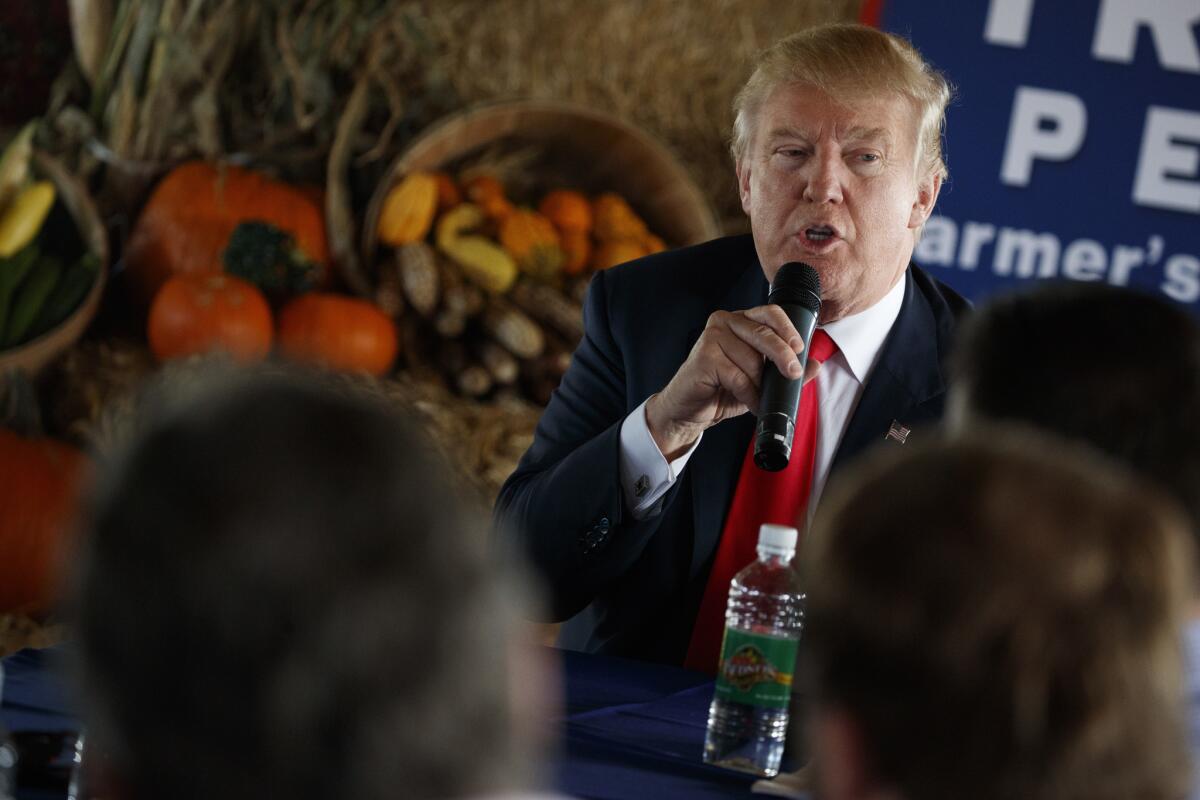Trump dispenses billions of dollars in aid to farmers, hoping to shore up rural base

- Share via
WASHINGTON — Moving to offset the impact his trade war has had on rural America, President Trump has bypassed Congress to send some $20 billion in aid to farmers, mostly going to a bundle of states that are essential to his reelection chances next year.
The payments have ranged from as little as $2 for some small-scale farmers to more than $1 million each for some corporate agricultural enterprises.
To sidestep Congress, which has long considered price supports for farmers its exclusive domain, the administration cited an obscure law from the 1940s that was passed in the aftermath of the Dust Bowl and the Great Depression.
Until Trump, no president had ever used that law to make direct payments to farmers, let alone tens of billions.
The strategy bears some resemblance to the one Trump used to shift millions of dollars that Congress appropriated for the military to pay for sections of his border wall. Unlike the border wall money, however, the farm aid has not drawn challenges from Congress, perhaps because Democrats have their own political reasons for not wanting to oppose help for rural areas in politically important states.
The payments are likely to reach nearly $25 billion by early next year, making them roughly twice the net cost to taxpayers of President Obama’s auto industry bailout during the Great Recession of 2008. Even so, they may fall short of fully covering farmers’ losses from the trade war with China or fully mitigating the political fallout Trump has faced in some Midwestern communities.
It’s not that farmers are in open revolt against Trump. Surveys and interviews suggest most are sticking with him and hoping for the best. But the trade war’s impact — especially the uncertainty about future policies — could dampen enthusiasm come election day next year.
“Turnout is the key question: Are they just going to stay home or are they going to vote for Trump?” asked Katherine Cramer, a political science professor at the University of Wisconsin who has researched rural attitudes and the political and cultural divide between rural and urban Americans.
If farmers feel too pinched by the trade conflict, “the greatest impact will be a lack of enthusiasm — and they’ll stay home and not vote — which could make a huge difference,” she said.
For farmers, the cost of the trade war can be measured in lost markets in China, which has been by far the largest buyer of the soybeans and other grain crops that are the lifeblood of agriculture across the Midwest and Great Plains.
U.S. sales of soybeans to China exceeded $14 billion in 2016, but prices fell as trade tensions mounted. Soybean exports to China plunged to $3.1 billion last year.
Early last month, Trump announced that he and Chinese President Xi Jinping would shortly be signing a “Phase 1” agreement in which China would buy $40 billion to $50 billion of U.S. farm goods a year, about double the annual amount before exports to China plummeted last year.
That hasn’t happened.
And some farmers say they are wearying of Trump’s on-again, off-again rhetoric, with its still-unfulfilled promises of an imminent end to the conflict with Beijing.
Some farmers worry that China is developing new supply chains in Brazil, Argentina and elsewhere that may be hard to break even if the trade war ends.
Scott Henry of Nevada, Iowa, a small town roughly 40 miles north of Des Moines, backed Trump in 2016. And the 29-year-old, third-generation corn and soybean grower hasn’t given up on the president yet. Neither is he certain to vote for him.
“Trump has done just enough with tax policy and business regulations to keep people” supportive, he said.
But, he added, “I have no confidence that we’ll actually get anywhere on trade. What we’ve learned is there’s a lot of talk from this administration and very little action.”
Trump has “bought some votes from farmers” with the added farm spending, he said, adding that he’s a little troubled by the scale of the expense.
Blake Hurst, president of the Missouri Farm Bureau, said he was “very pessimistic about any progress being made on trade.”
“So I think the conditions will be there for another round [of aid] in 2020. Politically, I’d be surprised if we don’t get some attention next year.”
In launching the new payment program, administration officials used a “truncated rule-making process,” said Jonathan Coppess, an expert in agricultural law at the University of Illinois. That’s raised concerns about the administration’s legal authority and methodology.
Trump justified the spending by claiming that he was using tariff money collected from China to pay for it.
But U.S. importers and American consumers, not China, foot the bill for tariffs on Chinese imports. And the cash payments to farmers actually come from taxpayer funds through the borrowing authority of the Commodity Credit Corp., acknowledged Richard Fordyce, the Department of Agriculture’s Farm Service Agency administrator.
In an interview, Fordyce said the administration moved ahead of Congress because it saw the need and wanted to respond directly to the impact from retaliatory tariffs.
“The payments are coming at a time when the farming years are very cyclical,” he said. “These payments are coming at a time when it’s critically important for them and their farming operations.”
Even before Trump launched the trade war with China in 2018, many American farmers were struggling. Total net farm income dropped in 2014 and every year since. Farm bankruptcies have been rising.
Taken together, federal subsidies may end up accounting for roughly a quarter of the nation’s total farm net income this year, agricultural experts say.
The problem was partly of farmers’ own making: The industry had become so productive through years of automation and consolidation that it was yielding larger and larger supplies. Yet domestic demand wasn’t keeping up, creating surpluses that have led to lower commodity prices and profits.
“It’s the export market that helps re-balance supply and demand,” said Chad Hart, an ag economist at Iowa State University.
Undoubtedly Trump’s cash injection has been important and life-saving for some farms. Without it, Ron Moore, 63, reckons he and other farmers would be driving their tractors to Washington in protest, as they did in 1979.
The Chinese “really like our soybeans, but we were told they can’t buy any soybeans from the U.S.,” said Moore, a farmer in Roseville, Ill., recalling his visit a year ago to China where he met with buyers.
After 42 years of farming, banks and other lenders are starting to lean on him, Moore added.
“They never used to ask me what my grain sales were. Now they’re asking, ‘How many contracts do you have? What have you sold?’”
Helpful as it’s been, he said, Trump’s aid “absolutely hasn’t made us whole.”
More to Read
Get the L.A. Times Politics newsletter
Deeply reported insights into legislation, politics and policy from Sacramento, Washington and beyond. In your inbox three times per week.
You may occasionally receive promotional content from the Los Angeles Times.











